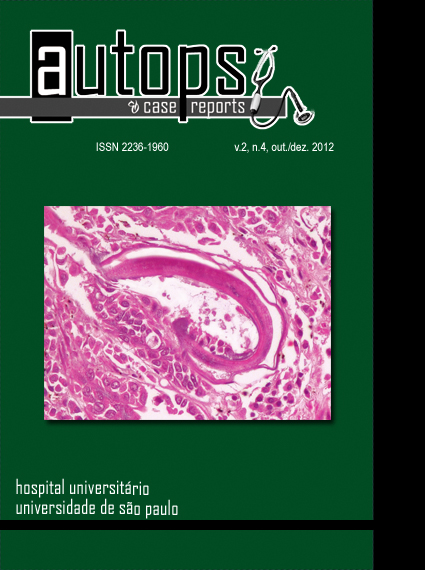Hepatic necrosis associated with drug-induced hypersensitivity syndrome
Keywords:
Liver failure, acute, Massive hepatic necrosis, Drug toxicity, Autopsy.Abstract
Drug-induced hypersensitivity syndrome (DIHS; also known as drug reaction with eosinophilia and systemic symptoms [DRESS]) is a life-threatening condition first described by Chaikenetal. in 1950. It is characterized by extensive mucocutaneous rash; fever; lymphadenopathy; hepatitis; hematological abnormalities; damage to several organs such as kidney, heart, lungs, and pancreas; and possible reactivation of human herpesvirus-6 (HHV-6) or other herpes virus. Rare and severe cases may present hepatic necrosis, and about 15% of them result in death or liver transplantation. A hallmark of this syndrome is the late onset of symptoms after the drug exposure. The most common culprit drugs are the aromatic anticonvulsants (in almost 30% of the cases) and the antibiotics (which in some series represent 20% of the cases). The authors report a case of a 41-year-old female who presented to the emergency department with erythroderma, acute hepatitis, acute pancreatitis and acute renal failure, and was then treated with corticosteroid after the diagnosis of DIHS/DRESS. A specific culprit drug could not confidently be determined due to the presence of multiple drugs used by the patient. The clinical and laboratory outcome was apparently satisfactory, but unexpectedly, on the sixth day of hospitalization, the patient complained of nonspecific malaise, drowsiness, which progressed in a few hours with signs and symptoms of hepatic failure, refractory shock, and death. The autopsy findings showed submassive hepatic necrosis, and the immediate cause of death was attributed to hepatic failure.Downloads
Download data is not yet available.
Downloads
Issue
Section
Article / Autopsy Case Report
License
Copyright
Authors of articles published by Autopsy and Case Report retain the copyright of their work without restrictions, licensing it under the Creative Commons Attribution License - CC-BY, which allows articles to be re-used and re-distributed without restriction, as long as the original work is correctly cited.
How to Cite
Campos, F. P. F. de, Lima, P. P. de, Maragno, L., & Watanabe, F. T. (2012). Hepatic necrosis associated with drug-induced hypersensitivity syndrome. Autopsy and Case Reports, 2(4). https://revistas.usp.br/autopsy/article/view/48238



